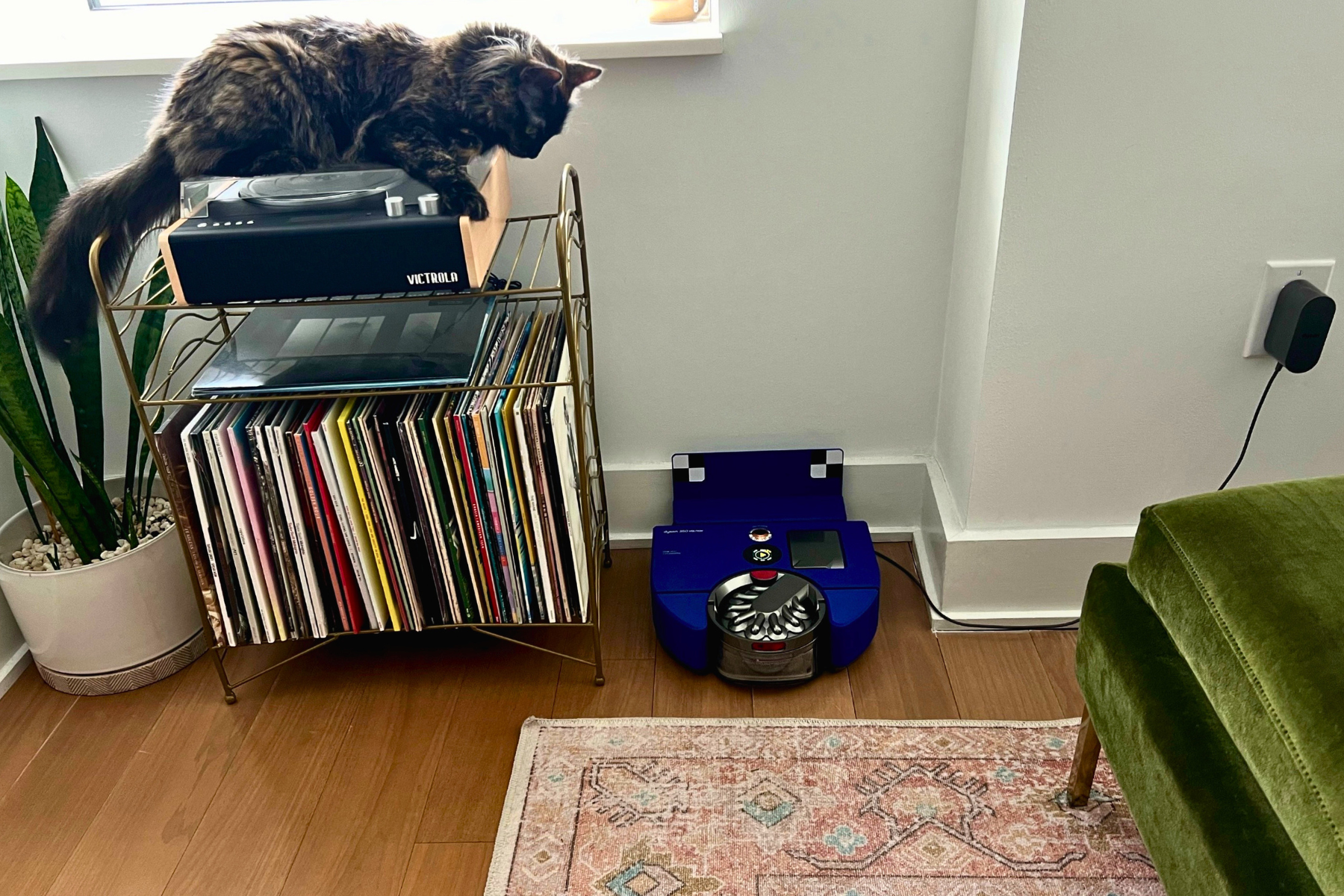
I’ll be the first person to tell someone to just grow up and buy a Dyson rather than settle for a cheaper cordless vacuum. Yes, the Dyson purchase probably requires extra saving up, and yes, I acknowledge that a vacuum costing the same or more than a month’s rent puts it in the “overpriced” category. But if you can swing it, I think a Dyson stick vacuum is worth it.
And this is simply because my Dyson does such a good job that it makes me prefer doing the chore manually. If a robot vacuum does a crappy job of cleaning a hard floor, my Dyson V12 Detect Slim will snitch immediately, using its green laser to highlight any leftover hairs or specks that a robot vacuum missed. It’s still clutch to be able to rely on a robot vacuum for surface-level jobs in a pinch, but for better or for worse, my ultimate robot vacuum test is how it stands up against my Dyson.
So what better robot vacuum to compete with my beloved Dyson stick vacuum than a Dyson robot vacuum? I went into my experience with Dyson’s new 360 Vis Nav with high expectations, despite already knowing about Dyson’s odd choice to omit crucial features like mopping and self-emptying. Here’s how it went.
Dyson rarely releases robot vacuums, so this was huge
The 360 Vis Nav initially sold out at Dyson’s website within hours of release on March 19. Stock subsequently dwindled completely at other retailers like Amazon and Best Buy within the following days. That’s not surprising — demand for a Dyson robot vacuum has been bubbling since 2016, which is the last time Dyson released a robot vacuum in the U.S. And it was a flop.
Eight years later, the premise of a Dyson robot vacuum feels much more auspicious. Dyson has perfected its cyclonic suction power in the realm of upright cordless vacuums, so it should have no problem converting that expertise to robot form, right?
The 360 Vis Nav came out with the promise of being the world’s most powerful robot vacuum, aided by a flat edge and a genius extending side duct for better corner cleaning than what a round robot vacuum can manage. A D-shaped robot vacuum is unique, but isn’t something we’ve never seen before. And it’s definitely not the most… interesting choice Dyson made with this physical design. Let’s start there.
This physical design will clash with a lot of home decor
You can tell a Dyson vacuum is a Dyson vacuum just by looking at it. The metallic gray bodies, bold pops of color, and chunky industrial details are pretty recognizable to anyone who has shopped for a vacuum before.
And I’ve never minded that boldness. My V12 Detect Slim, which is gray with a weird orange tentacle-looking piece on the dust bin and a purple filter cap, is a flex mounted on the wall in my kitchen.
That being said, Dyson should have reined in its signature design with the 360 Vis Nav, because it’s kind of an eyesore. Rather than sticking to graphite, the entire body is bright indigo. That is topped off with an exterior circular dustbin that was probably meant to give cool exposed gear vibes, but more so resembles a curled-up centipede.
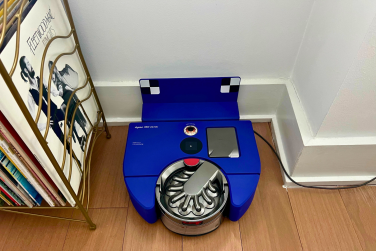
Credit: Leah Stodart / Mashable
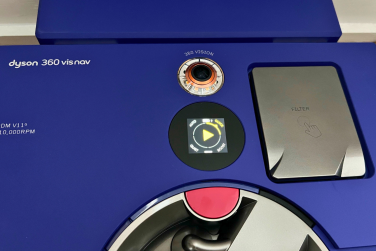
Credit: Leah Stodart / Mashable
I guess the polarizing design choice might be appealing to ultra-modern maximalists, but given my guests’ puzzled reactions when they see the 360 Vis Nav in my living room, it’s not exactly screaming practical.
Despite the fact that robot vacuums are becoming increasingly common, they can still feel a bit out of place — maybe too futuristic — in a lot of homes. Other brands have caught onto the consumer’s preference for chicness and subtly, with iRobot going as far as to make its Roomba Combo j9+ dock double as a wooden top side table.
So the dust bin isn’t concealed on the underside or back like it traditionally is on standalone robot vacuums. Yes, this means that the wad of gray dust will be facing outward until it’s time to empty. You’d be off the hook from that for weeks and weeks had Dyson included a self-empty dock, but at least the 360 Vis Nav’s 0.15-gallon dust bin is larger than most.
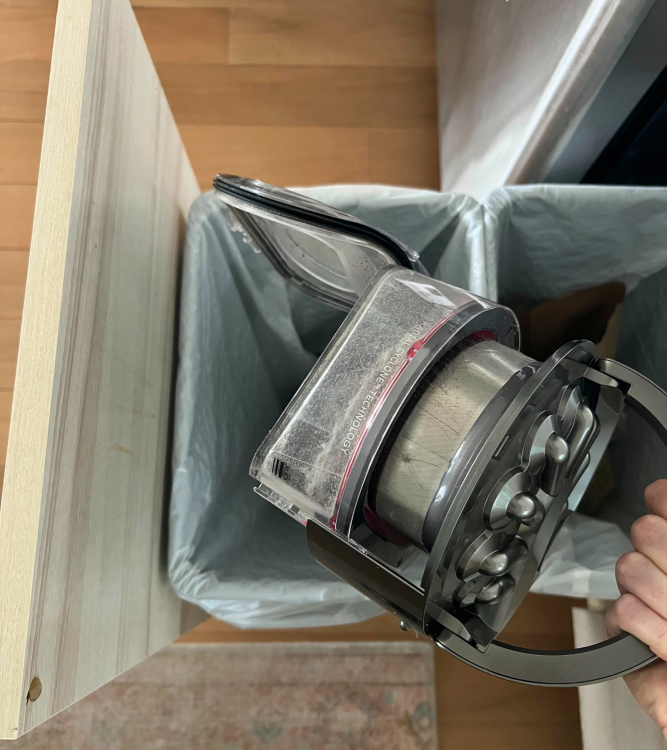
Credit: Leah Stodart / Mashable
And granted, if a robot vacuum is going to require manual emptying, Dyson’s system is definitely the mildest pain in the ass. Just pull up the handle and un-click the bin while the vac is charging, hold it over a trash can, and push the red button. The door swings open downward and everything falls directly in the trash.
Speaking of questionable design choices, not even the religious RuPaul’s Drag Race stan in me can justify the black and white checkered flags stuck to the 360 Vis Nav’s dock. This thin panel needs to be attached in order for the vac to map correctly and find its way back. Without it, the 360 Vis Nav looks like me trying to parallel park. No other premium robot vacuums I’ve tested require obnoxious stickers to drive themselves. Just saying.
Smart mapping is accurate, but customizing zones is frustrating
A small LCD touchscreen and a small transparent sphere known as the Eye sit atop the 360 Vis Nav. You use the touchscreen during setup when connecting to the WiFi, and I appreciate that all of the steps are laid out in very simple terms. You can also use the touchscreen to select from four cleaning modes (which you can also do on the app): auto, boost, quiet, and quick. They’re pretty self-explanatory.
The other piece of tech on top, the Dyson Eye, replaces the circular LiDAR tower that is seen on a lot of competing robot vacuums. The Eye has a 360-degree view of its surroundings and, with the help of 26 different sensors, is said to analyze up to 10,000 data points a second, allowing it to remember your home’s layout and navigate around large obstacles like furniture and walls.
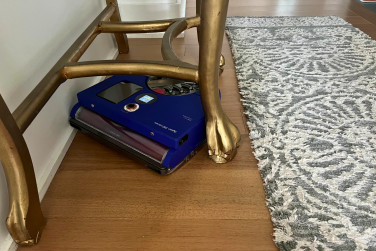
Credit: Leah Stodart / Mashable
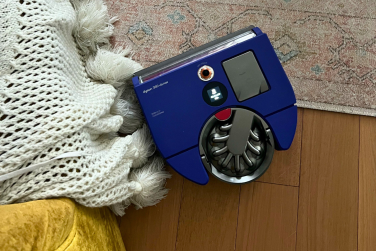
Credit: Leah Stodart / Mashable
The 360 Vis Nav’s mapping run proved to be quite accurate the first time around, at least when assessing the general perimeter of the floor plan. (Dividing rooms in the app wasn’t as seamless.) After each cleaning session, the MyDyson app offers what looks like a heat map version of its smart map, showing where it found the most dust. It’ll work harder in those areas the next time you start a full home cleaning.
Navigation-wise, the 360 Vis Nav is nimble when dealing with tricky furniture. It never got stuck once in my apartment, and was able to carve tightly around our acorn-shaped coffee table. I’m not over the lack of small obstacle avoidance technology, though. And I elaborate on these gripes in the downsides section of this review.
Suction power: Great on carpet, rough around the edges (literally)
Dyson alleges that the 360 Vis Nav has double the suction power of any robot vacuum. That’s honestly not totally unbelievable coming from a longstanding powerhouse like Dyson, but it is tricky to compare suction power on paper when other robot vacuums measure that in Pascals (Pa) while Dyson measures in Air Watts (AW).
Dyson does scale its robot vacuum’s motor the same way it does its cordless vacuums, making contextualizing suction power a little more tangible. The 360 Vis Nav houses a proprietary Hyperdymium motor that spins at up 110,000 RPM — faster than all cordless Dyson vacuums that retail for more than $649.99. However, that motor only creates suction up to 65 AW of suction power, which is nearly half of the suction power pumped out by Dyson’s cheapest cordless vacuum, the V8, which can often be found on sale between $300 and $350. As a reminder, the 360 Vis Nav costs $1,119.99.
Success stories first: The Dyson 360 Vis Nav is pretty stellar on carpet and rugs. It aced any debris test I threw at it, audibly boosting suction (in auto mode) when it came across a mess. These three piles of crushed tortilla chips, soil, and cat fur were totally cleared before the 360 Vis Nav went back to its dock, even when I was skeptical after it missed some pieces on the first pass.

Credit: Leah Stodart / Mashable

Credit: Leah Stodart / Mashable
The effectiveness is probably a combination of sheer suction power and the triple-action brush roll. It’s basically a spitting image of the one on Dyson’s Digital Motorbar cleaning head for its cordless vacuums, combining soft nylon, stiff bristles, and anti-static carbon fiber strands that dig into carpet pile, attract debris like velcro, and suck it out.
In terms of battery life, Dyson alleges that the 360 Vis Nav can run for 65 minutes. I was able to send the Dyson out to cover two rooms that took just under half an hour each, and it had enough juice for both on one charge. However, I can see this run time dwindling significantly if more of the floor is carpet or needs to be cleaned in boost mode.
Hard floors were more of a struggle than carpet, which is surprising because it’s usually the other way around for robot vacuums.
My bathroom is one place where I need a robot vacuum to reliably clean on a daily basis. It’s where one of my cats’ litter boxes is, and is where my hair sheds the most — and is the only place in the apartment where I always walk barefoot. So tell me why, on multiple occasions, I walked in there after a 360 Vis Nav run to see the back third of the floor still scattered with kitty litter and long hairs. Either the 360 Vis Nav’s suction did virtually nothing, or it didn’t attempt to go back there at all. Considering a $299 Shark robot vacuum successfully came to the rescue afterwards, neither of those excuses will fly.
Similarly, the laser on my Dyson V12 Detect Slim showed a decent amount of dust still remaining in front of the litter box in the kitchen after the 360 Vis Nav cleaned there.
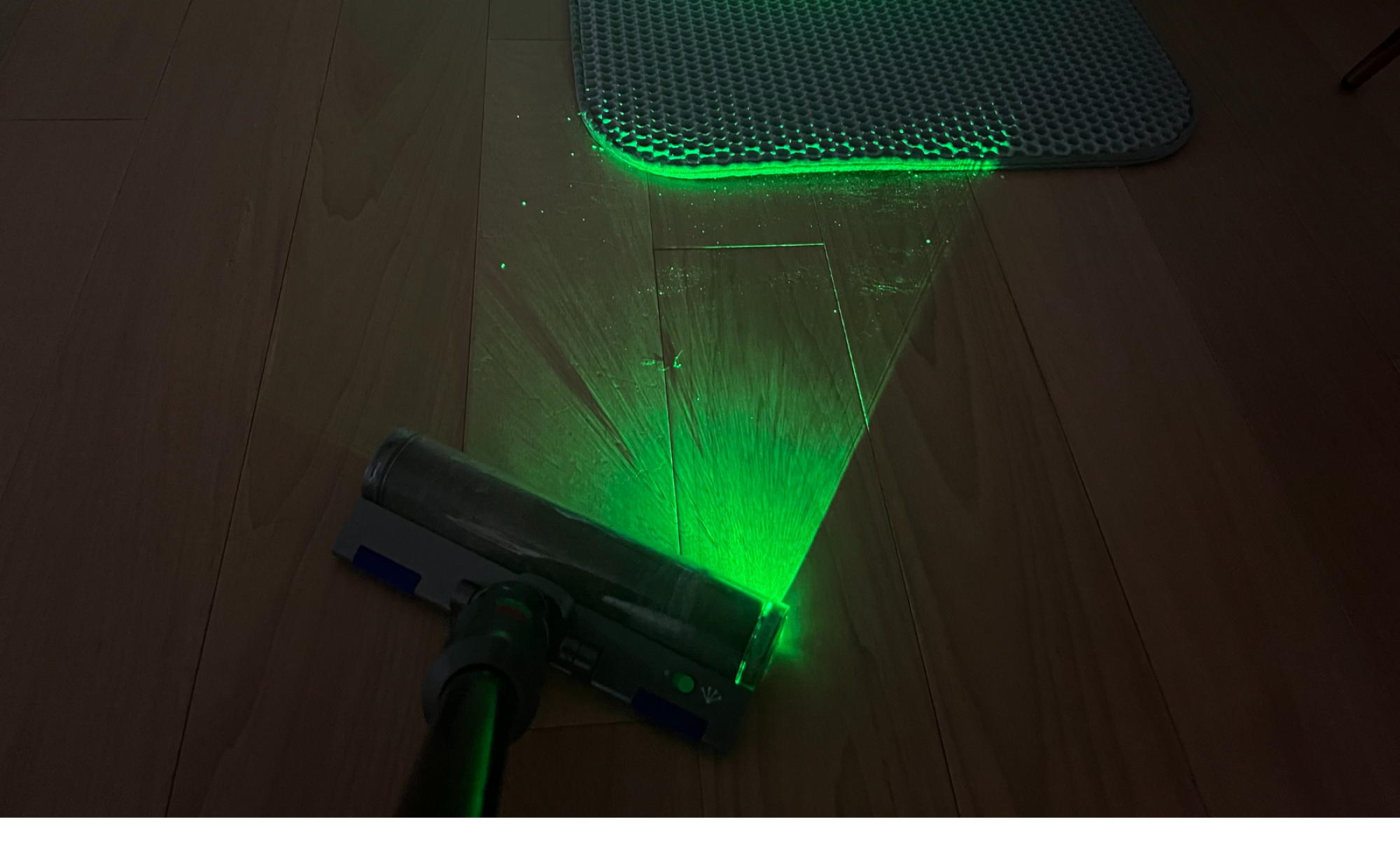
Credit: Leah Stodart / Mashable
Dyson’s hyped edge cleaning was a huge letdown
Aside from rocking a flat edge to scoot into 90-degree angles better than a round vacuum, the 360 Vis Nav is equipped with side ducts that extend when cleaning along a wall. These target suction power to the side of the vacuum that the wall is on, replacing the traditional flimsy spinning side brushes that operate on mere hope. This was going to be huge if true: Robot vacuums universally struggle to grab the dust bunnies that blew into the corner behind the couch or the crumbs pushed up against cabinets or appliances.
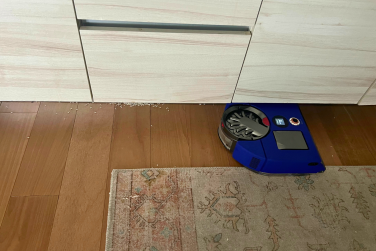
Credit: Leah Stodart / Mashable
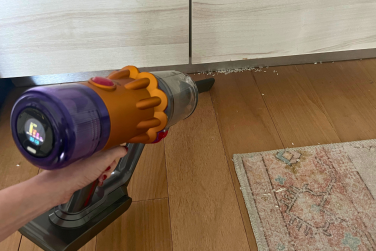
Credit: Leah Stodart / Mashable
Unfortunately, the 360 Vis Nav fell short of edge-pectations. During my spill-rice-on-purpose challenge, the vac did an OK (just OK) job at clearing the middle of the floor, but hardly grabbed any of the rice hanging out under the lip of the cabinets.
Downsides: Dyson skipped crucial features, then charged too much
My list of cons of the 360 Vis Nav will be pretty straightforward — not because Dyson got very few things wrong, but because there’s actually not a ton of features to evaluate. No self-emptying, no mopping, no small obstacle avoidance. I’ll cover those in the section exploring the competition, but first, I want to touch on the features that are present, but disappointing.
There’s a lot of misplaced innovation going on here. Rather than ensuring some basic features that every high-end robot vacuum should have, Dyson put its energy into things like a touchscreen. That would have been cool if you could do anything more proactive than select the cleaning mode through it.
Similarly, I’ve already gone off about how the 360 Vis Nav doesn’t even reliably clean edges — the one thing it was supposed to excel at.
Spot cleaning is another huge miss. Sometimes, scheduling a cleaning for one room in particular isn’t specific enough. Sometimes, you just need to directly tackle the few feet surrounding the kitchen counter, or the front door, or the litter box. If the ability to physically pick the vacuum up, plop it in the spot that needs attention, and press a button on the top to make it go isn’t an option, I’ll settle for drawing a zone in the app.
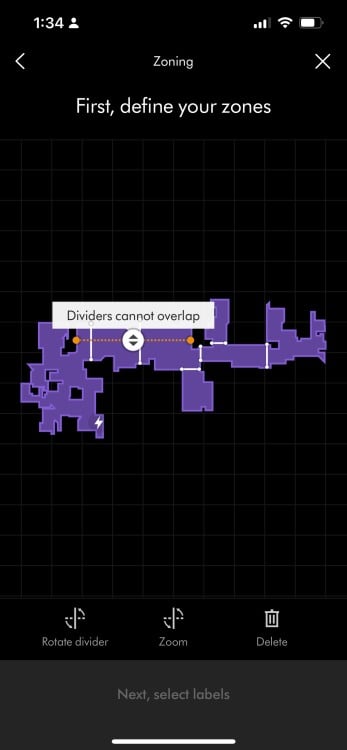
Credit: Leah Stodart / Mashable
The MyDyson app doesn’t differentiate between rooms and zones, despite referring to the entire room-labeling process as “zoning.” The most intuitive robot vacuum apps allow you to drag a rectangle onto whatever area of the map you desire for a one-time cleaning, no questions asked.
But if you want to spot clean with the 360 Vis Nav, you have to put dividers up just like you would when separating a bedroom from the hallway. That’d be fine if the dividers were easy to set up with your finger. But they barely respond to pinching or dragging, and then get mad at you for not being arranged correctly. This once again had me sending a $299 robot vacuum to cover those spontaneous spots.
The competition
Dyson’s choice to simply omit features like self-emptying and mopping is unforgivable at this price point. These “advanced” autonomy features may have been considered premium in 2020, but have become accessible at any price point in the past two years. You can easily score a robot vacuum that empties itself and mops for less than $500 even without a sale.
The competing robot vacuums in the same $1,000+ pricing tier are actually going far past just automatic emptying or just mopping, too. The theme of the robot vacuums announced at CES 2024 was fully self-sufficient mopping, including automatic washing and drying of the mopping pads. Considering Dyson just released a mopping version of one of its best cordless vacuums in Sept. 2024, it’s surprising that its robot vacuum ignores mopping completely.
The Roomba Combo j7+ is pretty good at cleaning and really good at not eating phone chargers
It’s also impossible not to compare the 360 Vis Nav to Dyson’s own stick vacuum lineup, especially when the 360 Vis Nav costs more than the most expensive cordless Dyson, the $1,049 Gen5 Outsize. That vac more than doubles the suction power and dustbin capacity of the 360 Vis Nav, plus can be trusted to get into corners. Yes, you’ll be the one doing the work, but it’s actually fun when you’re guided by a game-changing laser that highlights exactly where dust and debris are. You already know I back the V12 Detect Slim, which can often be snagged for less than $500.
Is the Dyson 360 Vis Nav worth it?
Nope. And that’s not an “unless you have the budget to spend over $1,000 on a robot vacuum” nope. It’s just a hard nope.
Similarly-priced competitors empty themselves, mop, wash and dry their own mopping pads, and can detect small obstacles like cords, pet waste, and socks. The 360 Vis Nav doesn’t do any of that, and doesn’t even ace edges, the main thing it claimed to be good at.
And even if the 360 Vis Nav wasn’t drowning in competition from other robot vacuums, it would still lose to its number one enemy: its own cordless stick vacuums.
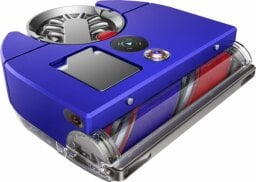
Opens in a new window
